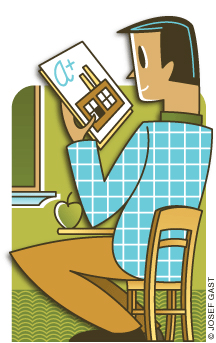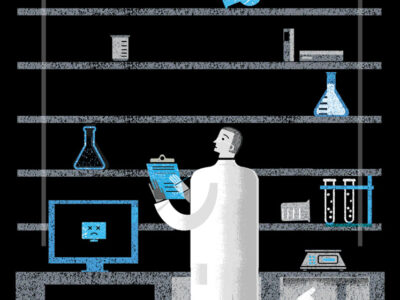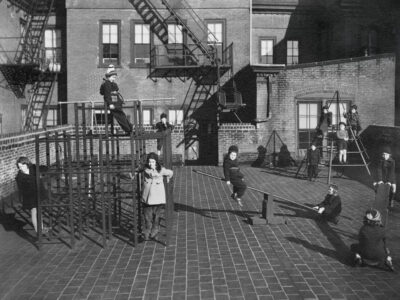
Three years into his career as a public high-school history teacher, Tim Woods didn’t delude himself that he could answer every question a student might throw his way. But when a hand shot up toward the end of a unit on the rise of American industry, he was unprepared for just how basic such a stumper could be. As Woods “lazily tried to contain all of the rich industrial history of Philadelphia into a brief class discussion,” one of his 11th graders came out with it.
“Why are there so many abandoned factories in my neighborhood?” she asked.
“It just floored me,” the 30-year-old teacher recalls. “When you do American history, it seems like after you’re done teaching about the Constitution and the Revolutionary War, you really don’t revisit Philadelphia again. And I think that’s very dangerous.” For his students at Randolph Career and Technical Academy, that curriculum gap left the very streets they lived on shrouded in total mystery. After reeling off an impromptu response that only led to more confusion, Woods promised himself that next time he would be prepared.
A year later, he had his answer. It took the form of an 8,000-word lesson plan, and was the product of an intensive semester in a fledgling partnership between Penn and the Philadelphia School District.
For the last three years, the Teachers Institute of Philadelphia (TIP) has been bringing public-school teachers into Penn classrooms for high-powered seminars with some of the University’s most esteemed professors. The subjects range widely, from immigration history to 20th-century literature to the use of probability and statistics in the social sciences. So far, about 90 West Philadelphia teachers—from kindergarten through 12th grade—have used the program to design approximately 130 detailed curriculum units for their own classrooms.
“Research has shown two things that seem to have an effect on student achievement,” says Alan Lee, who taught in Philadelphia public schools for 35 years before becoming TIP’s founding director. “One is [reducing] class size … but that’s the single most expensive thing you can do in education, which means it’s not going to happen in poor neighborhoods. The other bit of research that seems to be supported again and again is teacher quality—teachers with greater command over their subject matter tend to do better and be more effective with students than teachers who aren’t. That’s where we come in.”
The program is open to teachers who work in West and Southwest Philadelphia, where many schools have failed to make “adequate yearly progress” multiple times since the passage of the No Child Left Behind Act. Participants choose from one of about five seminars offered each spring by Penn faculty. Over a span of 14 evening sessions, they channel the new academic content into individual lesson plans that fulfill the school district’s curriculum requirements.
At their best, these lesson plans reflect serious scholarship, says Annenberg Professor of History Walter Licht, who has been involved in the program from the beginning. “There are at least five or six units that have been done for me where this is master’s-level work—even maybe doctoral-level work.” When a Penn Museum exhibit of Chinese porcelain caught the attention of an elementary-school teacher named Mona Kolsky, she used Licht’s seminar on American capitalism as a springboard to investigate trade with China in the early decades of the republic. Tapping into the archives of Philadelphia shipping merchants, Licht says, “she put together a historical narrative that has already made me change two of my lectures.”
Licht, who was a classroom teacher in Harlem long before becoming chair of Penn’s history department, thinks he has a pretty good idea what drives TIP participants to spend three hours a week around a seminar table after exhausting days in front of their own blackboards.
“Most teachers receive fairly watered-down educations academically in teacher training schools, and many wind up teaching content that they know little about,” he says, noting that the traditional two-year education degree has shrunk in recent decades to a 12- or 14-month stint devoted largely to student-teaching. “Classroom management and pedagogy has its place, but it’s not intellectually stimulating.”
The teachers echo that sentiment. “We want quality professional development,” says Rita Sorrentino, a veteran computer teacher at West Philadelphia’s Overbrook Elementary. “What we get in our schools is either canned or packaged … You pay your money, you get the handouts, and then you go home and it’s up to you to know what to do with it.”
By contrast, TIP equips them with a Penn library card, faculty that are often at the cutting edge of their fields, and the opportunity to connect primary-source research to their own classrooms. “And because you make this investment in learning the content,” says social-studies teacher Sam Reed, “when you take it back to your students they’re enriched by your enthusiasm.”
At Penn, it’s the enthusiasm of Rogers Smith, the Christopher H. Browne Distinguished Professor of Political Science, that’s largely responsible for the creation of TIP. Smith came to the University from Yale, where the Teachers Institute model was born in 1978. The Yale-New Haven Teachers Institute is permanently endowed as a unit of the university—something the TIP leadership at Penn would love to accomplish—and is currently on a mission to replicate itself in other states. Penn became the fourth member of the League of Teachers Institutes in 2007.
“I am a product of the public schools up until graduate school,” says Smith, who earned his PhD from Harvard. “I think the decline in public education in the cities is a huge problem in this country. And it’s something where university faculty members have some expertise they can bring to bear.
“Schoolteachers are desperate for forms of professional development that focus not on pedagogical technique, with which they have a lot of experience and training, but content knowledge. Well, we can bring content knowledge to the teachers, and then they can figure out how to adapt it in ways that communicates it to and inspires their students.”
Some TIP participants have designed lessons that involve their students in impressively creative ways. Rita Sorrentino wrote a history of her school’s neighborhood that “could easily be translated into an academic article,” says Licht. “But that was just for starters.”
As the school’s computer teacher, she then got her pupils to wrap some of that history into podcasts. “So their parents come,” Licht says, “they get an iPod, and they walk through the neighborhood while the iPod tells them all about this and that building—and it’s the kids’ voices. And then she did map work. It’s absolutely brilliant. It just dazzled me.”
To adapt her research on the early China trade for 5th- and 8th-graders, Mona Kolsky got her kids to record the origin of household objects and heirlooms—setting up an instructive comparison between the current era of globalization and a previous one.
It’s no accident that many curriculum units end up with a local focus. Alison McCartney, who teaches Spanish and English at Roxborough High, enrolled in Licht’s 2008 seminar on Philadelphia and immigration hoping to fill a yawning knowledge gap among her students. “I asked them, ‘Where do Spanish-speaking people come from?’ And they said 5th and Cayuga,” she laughs. “Well, okay, but how about before that?”
In TIP’s first two years, teachers have developed lesson plans with titles like “Neighborhood History Through Mathematical Analysis,” “The History of African-American Business in Philadelphia, 1850-1920,” and “Tell Me About It: The Africa I Left Behind.” And of course there’s Tim Woods’ unit, “Why Are There Abandoned Factories In My Neighborhood?”
“That’s an excellent example,” says Rogers Smith, “of how the teachers are able, through the institute seminars, to prepare curriculum units that have substantial historical content about the American economy and American politics, but all structured in ways that speak directly to the everyday experiences of their students. And it’s therefore much more likely to engage them than standard textbooks—and teachers are much more excited about teaching them.”
Whether that excitement translates into measurable classroom results is a question that has not been fully answered. “We don’t have, at this point, a systematic assessment of the impact on students and student responses,” Smith says. Other sites with Teachers Institutes have gotten “strongly positive” feedback from follow-up exercises like focus groups with teachers and students, he adds, but a more quantitative study remains to be done.
Licht would like to see TIP collect more data on the implementation of curriculum units and whether students are benefiting, but he also contends that getting teachers fired up is a worthy end in itself. “Frankly, I feel that if we can take some teachers and get them re-energized, that’s the greatest payoff,” he says. “I think that whatever happens in the classroom in terms of curriculum development is icing on the cake.”
Currently TIP is trying to spread that intellectual rejuvenation beyond its own seminars. It has linked up with the Graduate School of Education’s Teach For America Urban Teacher Master’s program, sending some of its own alums to lead workshops based on their own experience writing curriculum units. Also, to earn the $1,000 stipend supplied by the city school district, TIP participants must make their completed lesson plans available to other Philadelphia teachers—and, via the Web, to teachers worldwide.
The underlying hope is that even though the model relies on small seminars, the open-source nature of the lesson plans will foster a multiplication effect. Lee says that evaluations from the first two years indicate that about 90 percent of the participants expected to share their units with colleagues. Plus, one teacher’s involvement with TIP often encourages others to follow suit. That has been Rita Sorrentino’s experience. “For the first two years, I was the only teacher in my school” enrolled in the program, she notes. “I’m so happy that now there are four. It makes the level of conversation in your building rise.”
Bonnie Breeze, who teaches English at Overbrook High School, where the graduation rate barely tops 50 percent, says that the effect isn’t limited to the teachers lounge. “Any time you tell your students, ‘I learned this at Penn,’ or, ‘I learned this at Yale,’ they’re ready,” she says. “They’re feeling that they’re linked. And that gives me a credibility far beyond what I ever thought I would have as a teacher.”
In dollar terms, TIP has so far managed to do a lot with a little. Lee credits gifts from Penn parents George and Pamela Rohr, and Dean Adler W’79 L’83 and Susanna Lachs CW’74 ASC’76 for powering the first two years of the program, but adds that financial stability is still a ways off. “We don’t get money from the University itself—they support us in indirect ways—so we’re out there beating the bushes for support.”
But even though his director’s office resides in a decidedly austere and harshly lit basement, and even though he waited two years to get his first administrative assistant, Lee is convinced that this is the best way to keep making an impact on public-school classrooms. Bringing classroom teachers into the ivory tower isn’t just consonant with Penn’s social mission, he says, it’s common sense.
“Every five years there is a new wave of reform—the new silver bullet, the new reforms which will undo the damages of the previous reforms. And at various times these reforms seem to hint rather darkly that it’s the teachers that are the problem,” he observes. “Teachers should not be the objects of reforms, they should be the agents.”
—T.P.




